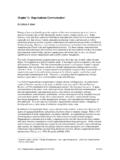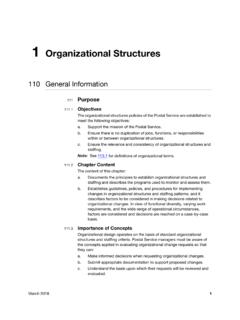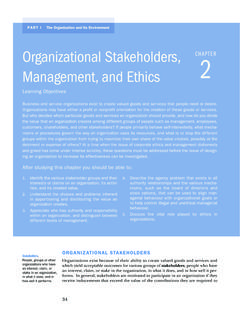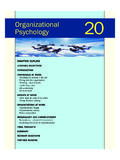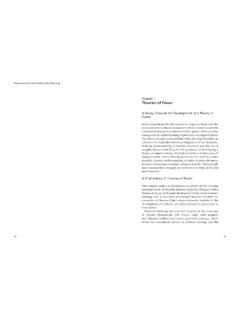Transcription of Processes Organizational Culture, Chapter 14 …
1 Chapter 14 PART 6:OrganizationalProcessesOrganizationalC ulture,Creativity, andInnovationChapter OutlineThe Basic Nature of Organizational CultureForms of Organizational CultureCreating and Transmitting Organizational CultureWhy and How Does Organizational culture Change?Creativity in Individuals and TeamsPromoting Creativity in OrganizationsThe Process of InnovationSpecial SectionsMaking Sense Out of Common SenseBeyond the CheerleadingIn a Diverse WorldWhere in the World Is Entrepreneurial Creativity Promoted?How to Do ItHow to Inspire 2/3/07 2:49 PM Page 542 After reading this Chapter you should be able to:Define Organizational culture and identify its core characteristics and the various func-tions it serves in the four major forms of Organizational culture specified by the competingvalues the factors responsible for creating and transmitting Organizational cultureand for getting it to creativity and describe the basic components of individual and team various approaches to promoting creativity in the basic forms and targets of innovation and the stages of the CaseApple.
2 Innovative to the CoreIn the aftermath of the dot-com bust of the late 1990s, most high-tech companies slashedtheir research and development budgets, but not Apple Computer. Following its image ofmaking the most elegant and easy-to-use computers, the Apple iPod has been not only thecompany s ticket to financial riches, but also the most influential new technology productin years (with million sold through the middle of 2006).The man behind this success is Apple s CEO, Steven Jobs. After founding the companyin 1976, he was ousted in 1986, only to come back aboard in 1997. It was then that the com-pany shifted into high gear with respect to innovation. A slew of new computers ( , vari-ous incarnations of the iMac, the Mac Mini, and others) and, of course, the iPod has madeApple one of the most highly regarded high-tech companies in the world.
3 The secret, Jobssays, is that We hire people who want to make the best things in the world, noting thatApple employees work very hard and care greatly about the products they products involve not only hardware, but software where one of the greatest inno-vations has occurred. The company s iTunes jukebox software program morphed into theiTunes music store, which is the first online music service to sell over 1 million songs in theform of downloaded files. Innovations of this type are controlled accidents, more or the company does not legislate innovation nor can it do so the creative spirit is inthe air throughout Apple s Cupertino, California headquarters. As Jobs put it, Innovationcomes from people meeting up in the hallways or calling each other at 10:30 at night with a newidea, or because they realized something that shoots holes in how we ve been thinking about aproblem.
4 It s ad hoc meetings of six people called by someone who thinks he has figured outthe coolest new thing ever and who wants to know what other people think of his idea. Personally, Jobs contributes to the company s innovative spirit when and how he spends some of his time sharing new ideas with the OS X team and some with thegroup doing iLife applications. I get to spend my time on the forward-looking stuff, because, as Jobs says, My top executives take half the other work off my plate. One of Apple s latest ideas and certainly its boldest called for moving to Intelchips in its computers, allowing Macs to run Windows software as well as its own operat-ing system. This shift, made in April 2006, was a clear effort by Apple to accommodateitself to the rest of the computer world.
5 Although many Mac aficionados have taken pridein Apple s distinctiveness from the dominant Microsoft Windows operating system, thislatest innovation was hailed by industry insiders as being in the best interest of the com-pany and the computer industry as a 2/3/07 2:49 PM Page 543544 PART 6 Organizational PROCESSEST here can be no doubt that Apple s software and hardware engineers bring a wealth of creativityand talent to their jobs. At the same time, it is not only their individual cre-ativity that makes Apple so effective at coming up with exciting new products, but also thecompany s commitment to be sure, there is something special about Applethat makes its engineers and developers so devoted to developing the best new special something is not in the form of magic found in the company s next whiz-bangproduct.
6 Rather, it is something far more human in nature Steve Jobs s infectious enthu-siasm and his willingness to make the best possible you have worked in several different organizations, it s probably been your experi-ence that each is unique in one way or another. Even organizations concerned with thesame activities or that provide similar products or services can be very different places inwhich to work. For example, in the world of retailing, Wal-Mart employees long have beenencouraged to be agents for the customer, focusing on service and con-trast, for many years, employees of Sears allegedly were forced to meet stringent salesquotas, which led them to pressure customers into making unnecessary large national chains selling a large variety of goods.
7 Somehow, these similar busi-nesses have taken very different approaches to customer service. Why is this so? To a greatextent, the answer rests in the shared beliefs, expectations, and core values of people in theorganization what is known as Organizational established, these beliefs,expectancies, and values tend to be relatively stable and exert strong influences on organi-zations and those working in these influences lies a particularly important one an organization s tendencytoward creativityand you know, some people regularly take novel, ingenious,and cutting-edge approaches to the problems they face. Likewise, some organizations Microsoft and Corning among them are far more innovative than others. It s unlikely thatpeople in one organization, by chance alone, will just happen to be more creative thanpeople in another.
8 Indeed, companies such as 3M, Toyota, and Rubbermaid go out oftheir way to breed the kind of cultures in which creativity and innovation flourish (seeFigure ).4 What makes these companies and others like them the kinds of places where peo-ple routinely do the nonroutine? This question, concerning the culture of creativity andinnovation, is the focus of this Chapter . We will begin by describing the basic nature oforganizational culture , including the role it plays in organizations. Then we will describethe Processes through which Organizational culture is formed and maintained. Followingthis, we will review the effects of Organizational culture on individual and organizationalfunctioning, examining when and how culture is subject to change.
9 This discussion willprepare us for understanding the nature of creativity and innovation in organizations, themajor topic covered in the second half of this Chapter . Finally, our focus will move fromconsideration of what makes individuals and teams creative, to how this creativity can beharnessed to implement innovative ideas in Basic Nature of Organizational CultureTo fully appreciate Organizational culture we have to understand its basic nature. With thisin mind, we will now examine five fundamental aspects of culture : (1) its formal defini-tion, (2) the key characteristics on which it is based, (3) the strength of Organizational cul-ture, (4) whether there is generally only one or more than one culture within organizations,and (5) the role that culture plays in Organizational culture : A DefinitionAlthough we have been talking about Organizational culture in general terms thus far, aspecific definition is now in order.
10 Accordingly, we define Organizational cultureas acognitive framework consisting of attitudes, values, behavioral norms, and expectationsshared by organization often think of Organizational culture as a setof basic assumptions shared by members of an cultureA cognitive framework consistingof attitudes, values, behavioralnorms, and expectations shared byorganization members; a set ofbasic assumptions shared bymembers of an 2/3/07 2:49 PM Page 544 Chapter 14 Organizational culture , CREATIVITY, AND INNOVATION545 Some management experts have likened the role played by Organizational culture to theroots of trees. What roots do for the life of a tree, culture does for the life and performanceof an organization. Just as roots provide stability and nourishment for trees, so does cultureprovide stability and nourishment for organizations.


